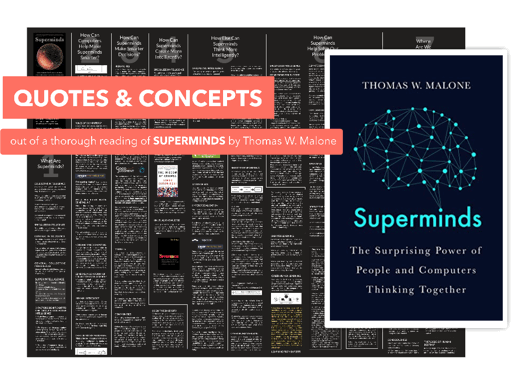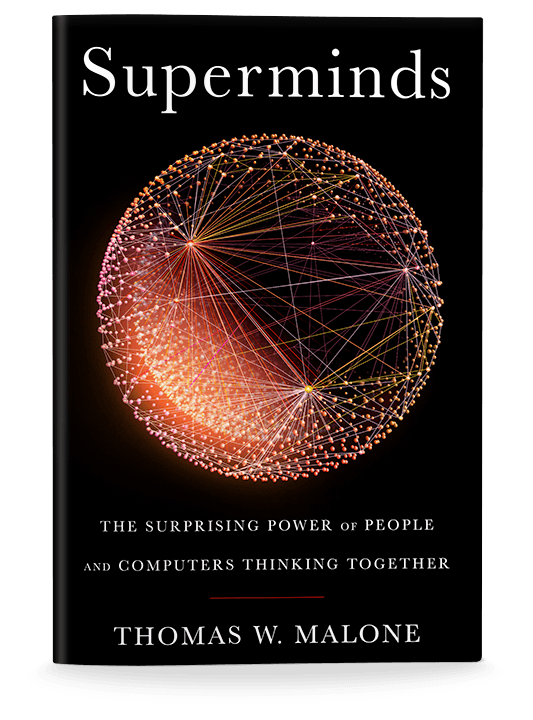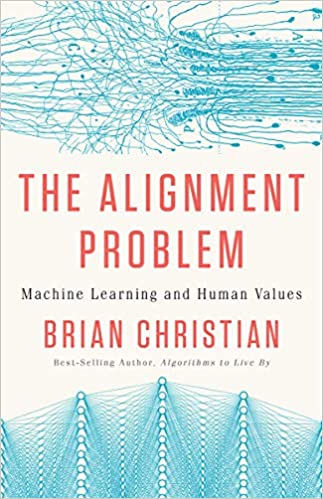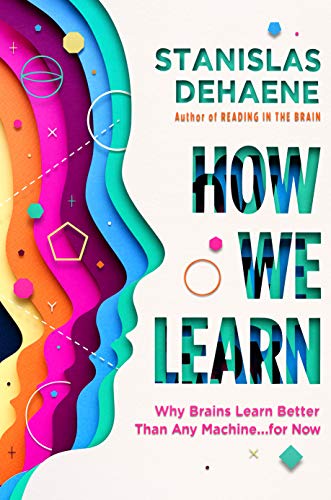I got this book into my hands while researching potential models for human & AI Apprentice cooperation. The wonderful essence of Tom’s book is to imagine how people and computers will interact on a massive scale to create intelligent systems. The author is both a management consultant and organizational theorist, as well as a Professor of Management at the MIT Sloan School of Management. His thinking about the impact of technology and the harnessing of both human and artificial minds make most of our thoughts on that subject seem… infantile.
Quotes and concepts
Here’s my visual depiction of quotes & concepts I listed when thoroughly reading the book:
Core concepts of the book:
- Collective intelligence — the result of groups of individuals acting together in ways that seem intelligent. 3 important factors in this regard are: (a) social perceptiveness (guessing mental states of the other participant), (b) the degree of equal participation and (c) the proportion of women in the group (a higher proportion of women makes the group more intelligent)
- Superintelligence with a formula to recognize it (as a group of individuals, their actions, interconnections and goals with respect to which evaluation can occur)
- Consciousness of groups – the line of reasoning attributing consciousness to corporations such as Apple, calling them superminds, having analogous experiences to what we humans have.
- Integrated Information Theory 3.0 – Due to a lack of any broad scientific consensus about how to measure consciousness, probably the best known and best developed attempt is the Integrated Information Theory. It defines different degrees of consciousness in different systems depending on how the information they process is integrated.
- The origin of the word Robot and its introduction in 1920 by the Czech play R.U.R.: Rossum’s Universal Robot.
- The logic of human destiny – at every stage of human development, there has been a tendency—not an absolute law, but a general tendency—for humans to form larger and larger groups that lead to a net improvement in human welfare.
- General collective intelligence understood as group versatility and adaptability.
- General AI as a form of collective intelligence – A “society of mind” emerges from the interactions of many smaller “agents,” none of which is very intelligent as an individual but all of which, together, create an overall system that is intelligent.
- Smarter Learning and two modes of learning – by Exploitation and Exploration
- Cyber-human learning loops will let machines watch humans prepare more complex returns and gradually learn what actions humans take in different situations. At first, the machines may just suggest actions to humans. Eventually, the machines can just automatically take the actions that humans always approve.
- How differences in structuring intelligent participants (hierarchies, markets and communities) correspond with needs.
- Human and cyber-sensing – letting the machines do the low-level sensing, then letting people do the higher-level reasoning. “Our great-grandchildren may find it hard to understand how the organizations we belong to in the early 21st century could have made so many of their decisions with their eyes—figuratively—closed.”
Superminds
by Thomas W. Malone
⭐⭐⭐⭐⭐
Published: May 2018
Length: 384 pages
Time to read: 9h
Related books
- Mar 2, 2021Jeff Hawkins and his team discovered that the brain uses maplike structures to build a model of the world-not just one model, but hundreds of thousands of models of everything we know, and the origin of high-level thought
- Feb 2, 2021“The ultimate guide to using the magical power of funny as a tool for leadership and a force for good.”—Daniel H. Pink, #1 New York Times bestselling author
- Oct 30, 2020How computer scientists and philosophers are defining the biggest question of our time - how will we create intelligent machines that will improve our lives rather than complicate or even destroy them?
- Sep 19, 2020How to integrate data teams into organization in an effective way, enabling executive data science practices.
- Jan 11, 2020An illuminating dive into the latest science on our brain's remarkable learning abilities and the potential of the machines we program to imitate them








